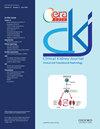单用巴西利西单抗诱导与 ATG-Basiliximab 双联法在 HLA 匹配度较低的首次活体供肾非致敏肾移植受者中的应用
IF 3.9
2区 医学
Q1 UROLOGY & NEPHROLOGY
引用次数: 0
摘要
背景 根据免疫风险进行个体化诱导治疗是优化肾移植预后的关键。方法 回顾性分析了 157 例首次活体供肾的非致敏肾移植受者(KTR)。其中有 96 人的 HLA 匹配度较低(5-6 个 HLA 不匹配)。低 HLA 匹配亚组被分为 52 例单独接受巴利昔单抗治疗的 KTR 和 44 例联合使用单次 ATG 剂量 1.5 mg/kg 和巴利昔单抗治疗的受者。主要终点是移植后6个月内的早期急性细胞排斥反应(ACR),次要结果包括感染率、肾移植功能、住院时间(LOS)和移植后再住院率。结果 与仅接受巴西利西单抗的低HLA配型KTR相比,接受ATG-巴西利西单抗的低HLA配型KTR的早期ACR发生率有所下降(9.1% vs. 23.9%,p = 0.067)。年龄是排斥反应的一个预测因素,亚组分析显示,不同年龄组的排斥反应减少率一致。在移植手术住院时间、围手术期并发症、感染率(包括 BK 和 CMV 病毒血症)、同种异体移植功能和移植后 6 个月内再入院次数方面均未观察到明显差异。结论 在 HLA 匹配度较低的非致敏首例活体供体 KTR 中,ATG-basiliximab 双联诱导方法可显著降低早期 ACR,同时不影响安全性。本文章由计算机程序翻译,如有差异,请以英文原文为准。
Basiliximab induction alone vs. a dual ATG-Basiliximab approach in first live-donor non-sensitized kidney transplant recipients with low HLA matching
Background Individualizing induction therapy based on immunological risk is crucial for optimizing outcomes in kidney transplantation. Methods A retrospective analysis included 157 first live-donor non-sensitized kidney transplant recipients (KTRs). Within this cohort, 96 individuals exhibited low HLA matching (5–6 HLA mismatches). The low HLA match subgroup was categorized into 52 KTRs receiving basiliximab alone and 44 recipients treated with a combined single ATG dose of 1.5 mg/kg and basiliximab. The primary endpoint was early acute cellular rejection (ACR) within 6 months post-transplant while secondary outcomes encompassed infection rates, renal allograft function, length of stay (LOS), and readmissions post-transplant. Results The incidence of early ACR was decreased for low HLA match KTRs, who received ATG-Basiliximab, when compared to low HLA-matched KTRs who received Basiliximab alone (9.1% vs. 23.9%, p = 0.067). Age was a predictor for rejection, and subgroup analysis showed consistent rejection reduction across age groups. No significant differences were observed in admission for transplant LOS or in peri-operative complications, nor in infections rate including BK and CMV viremia, allograft function and number of readmissions post-transplant up to 6 months post-transplant. Conclusion In non-sensitized first live-donor KTRs with low HLA matching, a dual ATG-basiliximab induction approach significantly reduced early ACR without compromising safety.
求助全文
通过发布文献求助,成功后即可免费获取论文全文。
去求助
来源期刊

Clinical Kidney Journal
Medicine-Transplantation
CiteScore
6.70
自引率
10.90%
发文量
242
审稿时长
8 weeks
期刊介绍:
About the Journal
Clinical Kidney Journal: Clinical and Translational Nephrology (ckj), an official journal of the ERA-EDTA (European Renal Association-European Dialysis and Transplant Association), is a fully open access, online only journal publishing bimonthly. The journal is an essential educational and training resource integrating clinical, translational and educational research into clinical practice. ckj aims to contribute to a translational research culture among nephrologists and kidney pathologists that helps close the gap between basic researchers and practicing clinicians and promote sorely needed innovation in the Nephrology field. All research articles in this journal have undergone peer review.
 求助内容:
求助内容: 应助结果提醒方式:
应助结果提醒方式:


